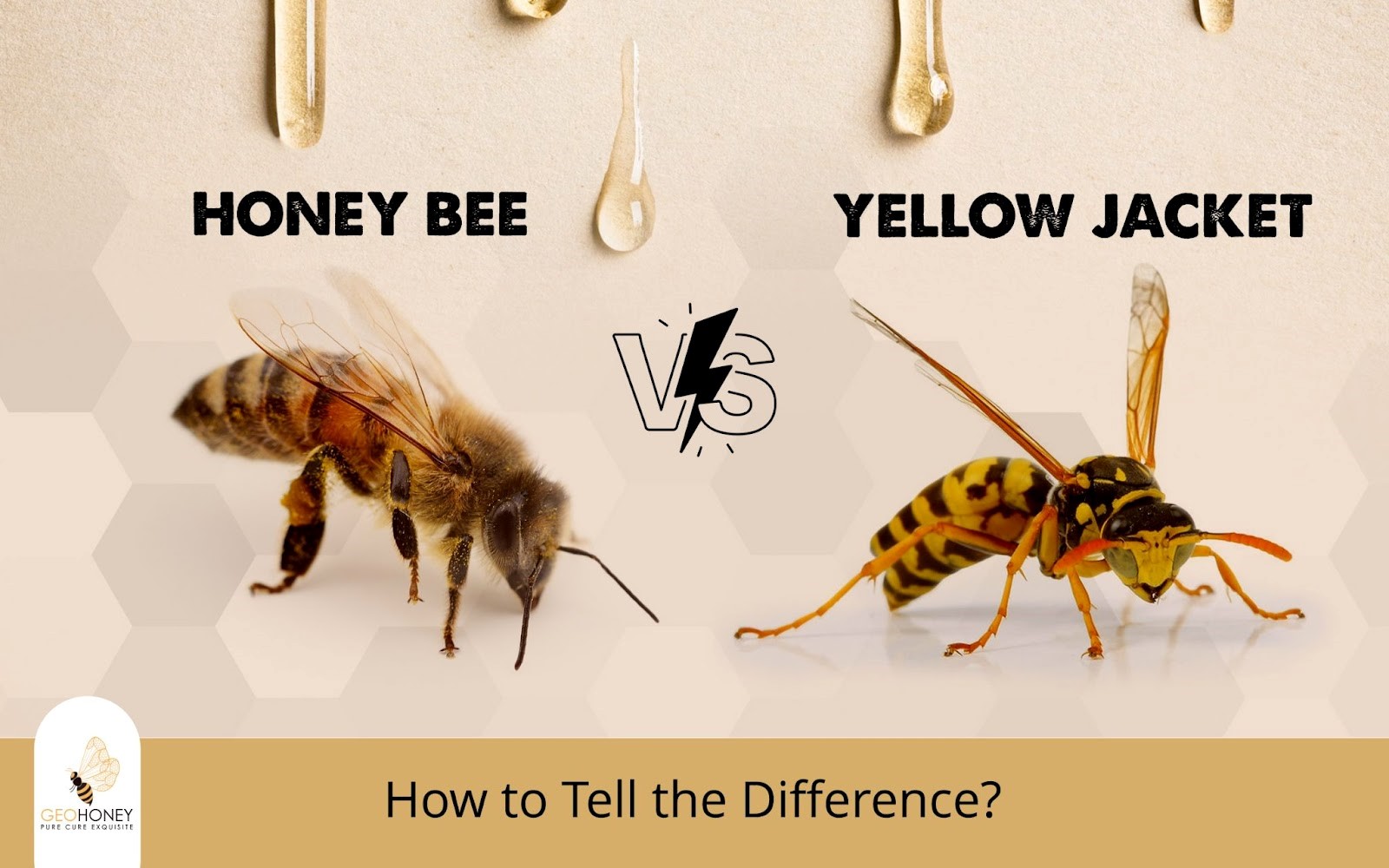- Tokyo: 14:45
- Singapore: 13:45
- Dubai: 09:45
- London: 05:45
- New York: 00:45
Honey Bee vs. Yellow Jacket: How to Tell the Difference

So many people confuse honey bees and yellow jackets for each other. The reason for this is probably their almost similar sizes, colors, and the buzzing sound they make. However, several things set both these buzzing insects apart from each other.
The founder of Geohoney and the CEO of B A Barry Group, Mr Basem Barry says
“Honey bees and yellow jackets are different in the way they behave, nest, feed, and more. You need to learn these differences to accurately pinpoint the insect you are currently dealing with”
In most cases, yellow jackets are behind the stings you get. These aggressive, territorial creatures are predatory wasps that can sting you for no reason and even more than once.
Honey bees, on the other hand, are generally harmless creatures that are also key pollinators. If you find it hard to separate these two flying insects then don’t worry.
This blog lists some of the main differences between honey bees and yellow jackets. So, keep on reading till the end to see what makes them unique.
Honey Bee vs. Yellow Jacket: Why It's Important to Know the Difference?
Key Differences Between Honey bees and Yellow Jackets
Physical Appearance
Behavioral Traits
Nesting Habits
Diet
Colony
Produce
Benefits
Before we look into what makes honey bees and yellow jackets so different, first, let’s discuss why is there a need for you to have this crucial information. Honey bees, as you might already know, are pollinators. These creatures are directly responsible for creating a sustainable global food supply by promoting reproduction in plants. Moreover, these bees also provide us with honey, propolis, royal jelly, etc. Unfortunately, due to deforestation, industrialization, and other human activities, the honey bee population is decreasing rapidly. So, to make sure you do not accidentally kill these valuable creatures, you need to know what makes them different from yellow jackets. Yellow jackets are very aggressive and quick to bite. The bites from these creatures can be painful and they can even lead to allergic reactions. Apart from that, these creatures are also natural enemies of honey bees. They attack weaker honey bee colonies to feed on honey, worker bees, and pollen in the hives. This is why you need to take immediate measures to get rid of these to protect both yourself and the local bee population. Following are a few points that will help you differentiate between honey bees and yellow jackets Honey bee species have golden brown or amber-colored skins with black stripes. These bees have fuzzy bodies which helps them capture pollen. These creatures are half an inch or slightly bigger in size. Honeybees have round bodies and wide wings. The flat hind legs of honey bees often look dusted due to the presence of pollen which is another way you can identify them. Yellow Jackets have shiny yellow and black bodies without any fuzziness. These bees have a bright yellow jacket that covers the black base and white or yellow faces. These creatures have slender bodies and wings. You can also identify these with their thin, pinched waist where the thorax and abdomen meet. The worker yellow jackets are typically half an inch in size while queens can grow as big as 0.75 inches. These creatures have jittery movements and frantic energy, unlike honey bees that are steadier in the way they move. Honey bees are naturally gentle and harmless unless you directly provoke them or they fear the hive is in danger because of you. These generally stay away from humans and prefer hovering over flora to collect nectar. Honey bees only sting you as a last resort to defend themselves and this action costs them their lives. Yellow Jackets are more aggressive and they are very possessive about their territories. They are always on the lookout for meat, fruits, sweet liquids, or other insects. This brings them frequently near humans. Unlike honey bees, yellow jackets can sting you again and again which makes them a bigger threat. Yellow jackets are particularly more aggressive during early fall and summer since their food supply is very little during this time. They appear more relaxed during springtime since they have plenty of food to last them the season. Honey bees live in hives that they create from the wax secreted by their bodies. These hives are mostly found in hollow trees, hanging from tree branches, or in wall cavities. The hives are a collection of hexagonal cells where pollen and nectar are stored as food for the young. These bees can also live in man-made hives. The nests of the Yellow Jackets are mostly underground and they are made from paper fibers or chewed wood fibers by the queen. The colonies of these creatures can also live in voids or under the eaves of the walls. The nests are covered with a single opening. Honey bees are mainly herbivores and they feed on plant nectar or pollen. When foraging is not an option, they feed on honey or royal jelly stored in the hives. Yellow Jackets, being omnivorous, can consume flower nectar, human foods and drinks, beetle grubs, flies, and a wide range of other insects. Honey bee colonies can consist of 60,000 or more bees. The queens lay eggs, drone bees mate, and female workers are charged with foraging or building hives. The yellow jacket colonies are smaller. A typical colony of such insects has about 5,000 members. Yellow jackets hibernate during the winter which means there is no need for them to store food in the nests for the winter. Honey bees produce beeswax, organic honey, propolis, and royal jelly. Honey is a natural alternative to sugar which has been a part of the human diet and medicine for centuries. Unlike honey bees, Yellow Jackets do not produce any of these resources. Honey bees promote reproduction in plants by scattering pollen from male parts or anthers of flowers to the female parts or stigmas. This way they are directly responsible for creating crops that humans feed on. Moreover, they also produce honey which humans utilize for medicinal and healing purposes. Yellow Jackets can also pollinate plants but they are less effective for this purpose. These creatures feed on garden pests like flies, caterpillars, etc. By keeping the number of these pests down, Yellow Jackets allow you to maintain healthier green spaces. It is very important to note what makes honey bees and yellow jackets different. This is the only way you can determine whether to get rid of them from your property or not. Honey bees are nature’s pollinators and they are mostly harmless unless provoked. They create honey, beeswax, and royal jelly all of which have many culinary and health benefits. If seen in your property, it is better to leave them be as they are constantly declining in number. Yellow Jackets on the other hand are highly aggressive and they can cause an infestation if left unchecked putting your safety and the property at great risk. This is why you need to get rid of these immediately after identification. You can visit us at GEOHONEY today to buy the best pure monofloral honey to have something, sweet, natural, and healthy to eat every single day. Honey Bee vs. Yellow Jacket: Why It's Important to Know the Difference?
Key Differences Between Honeybees and Yellow Jackets
Physical Appearance
Behavioral Traits
Nesting Habits
Diet
Colony
Produce
Benefits
Conclusion




IT IS VERY IMPORTANT TO KNOW THESE DIFFERENCES FOR TWO DIFFERENT BUZZING INSECTS.